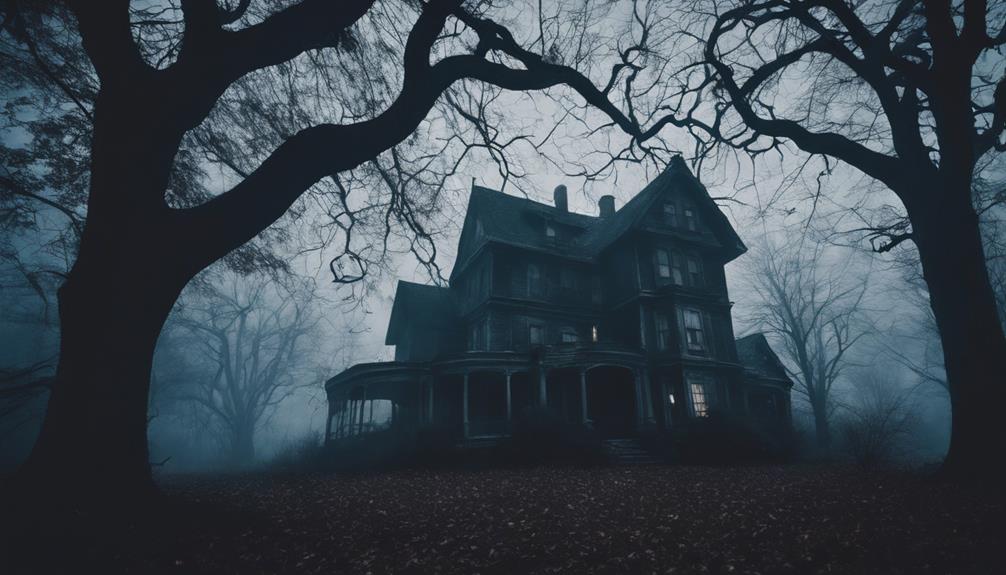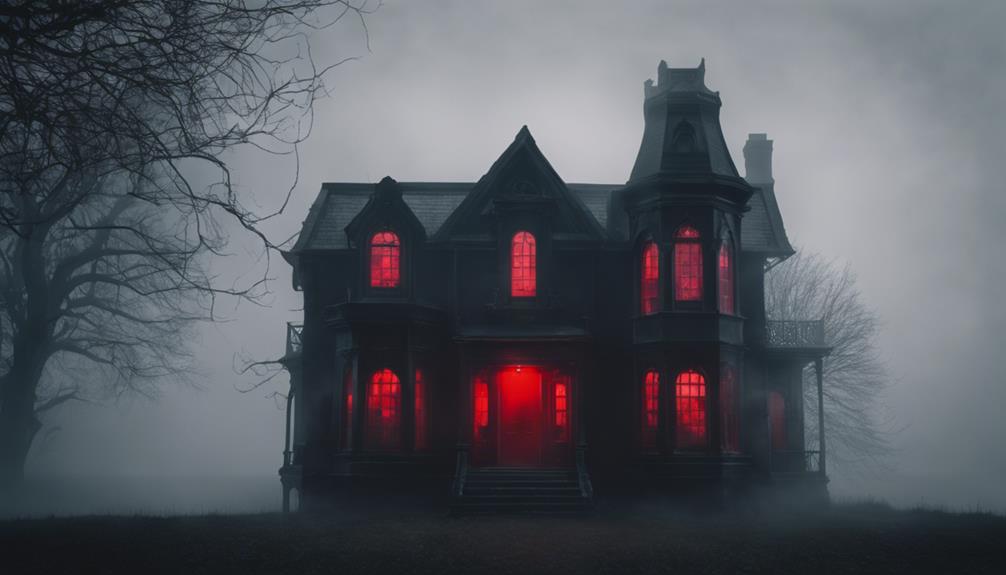The chilling events experienced by the Lutz family at the infamous Amityville house serve as the harrowing real-life inspiration behind the classic horror movie adaptation, 'The Amityville Horror.' The Lutzs encountered chilling paranormal phenomena such as strange odors, cold spots, and unsettling visions, escalating to a point where they fled in fear. These terrifying encounters, including visions of levitating objects, eerie voices, and swarms of flies, captivated the public and continue to fuel the enduring intrigue of the Amityville haunting. The legacy of their harrowing experiences stands as a cautionary tale of unexplained forces, drawing attention from both skeptics and enthusiasts.
Key Takeaways
- The Amityville Horror movie was inspired by the Lutz family's terrifying encounters in 1975.
- Real-life murders of the DeFeo family in 1974 at 112 Ocean Ave. served as the foundation.
- The Lutz family's paranormal experiences at the Amityville house influenced the horror genre.
- The legacy of the Amityville Horror continues to captivate audiences worldwide.
- Film adaptations and retellings have solidified the Amityville house's status in popular culture.
The Lutz Family's Terrifying Encounters
The Lutz family encountered chilling paranormal phenomena at the infamous Amityville house in 1975. During their brief 28-day stay, they faced a series of terrifying encounters that would later inspire the creation of 'The Amityville Horror'.
Strange odors permeated the air, cold spots lingered in certain areas, and unsettling visions plagued the family members. These supernatural occurrences escalated rapidly, driving the Lutz family to flee the premises in fear.
The Amityville house's dark history seemed to manifest itself through these eerie events, leaving a lasting impact on the family. Despite skeptics questioning the validity of their claims, the Lutz family's story continues to captivate audiences and fuel debates about the existence of the paranormal.
The legacy of their harrowing experiences in the Amityville house serves as a cautionary tale of the unexplained forces that may lurk within supposedly ordinary homes.
Paranormal Phenomena in Amityville House

Paranormal phenomena manifested in various forms at the Amityville house, unsettling the Lutz family and sparking a wave of fascination with the unexplained.
George and Kathleen Lutz's accounts of their time in the infamous Amityville house at 112 Ocean Ave. in New York detailed a series of chilling events that included poltergeist activity, ghostly apparitions, and other supernatural occurrences.
These reported experiences, following the real-life murders that had taken place at the residence, captivated the public's imagination and contributed to the enduring legacy of the Amityville Horror.
The Lutz family's claims of encountering inexplicable disturbances within the walls of the haunted house drew attention from paranormal enthusiasts and skeptics alike, leading to a proliferation of books, films, and documentaries exploring the alleged hauntings.
The eerie tales of the Amityville house, characterized by its distinctive 'eye-like' windows, continue to intrigue those interested in the intersection of the supernatural and the real world.
Unexplained Noises and Ghostly Apparitions

Mysterious footsteps echoing through the empty halls at night, eerie shadow figures flickering in the corners of the room, and haunting whispers barely audible yet chillingly present – these are just some of the unexplained noises and ghostly apparitions that have plagued countless individuals.
Such inexplicable phenomena have been reported in homes, abandoned buildings, and even open fields, leaving witnesses bewildered and unnerved by the otherworldly occurrences.
Despite attempts to rationalize or debunk these experiences, the allure of the unknown continues to captivate and terrify those who encounter these spectral manifestations.
Mysterious Footsteps at Night
In the dead of night, eerie footsteps echoed through the empty halls, sending shivers down the spines of those who dared to listen. The residents of the haunted location often reported hearing mysterious footsteps with no visible source, adding to the chilling atmosphere of the place.
These unexplained noises were frequently accompanied by sightings of ghostly apparitions, making the phantom footsteps even more unsettling. Witnesses described the footsteps as slow, deliberate, and unnerving, with some accounts mentioning the sound of footsteps descending stairs or pacing in empty rooms.
The combination of the eerie sounds and the inexplicable nature of the phenomenon created a sense of unease that lingered in the air long after the footsteps had faded away. Despite attempts to explain away the occurrences, the mystery of the mysterious footsteps continued to haunt the residents and visitors of the location.
Eerie Shadow Figures
Amid the darkness of the haunted location, witnesses often encountered eerie shadow figures darting in the corners of their vision. These dark silhouettes, described as fleeting shadows or shadowy figures, appear suddenly and disappear just as quickly, leaving those who witness them with feelings of unease and dread.
Alongside these ghostly apparitions, unexplained noises like whispers in the dark and footsteps further contribute to the chilling atmosphere of these paranormal encounters. Reports of such encounters are commonly associated with haunted locations, where individuals have reported encountering these unsettling phenomena.
The combination of unexplained noises and sightings of shadowy figures adds to the mystery and fear that surrounds these haunted places. Despite efforts to explain these occurrences, the presence of these eerie shadow figures remains a chilling and enigmatic aspect of the supernatural encounters reported by witnesses in these locations.
Haunting Whispers Heard
Whispers of the unknown echoed through the Herrmann family's haunted home, sending chills down their spines as they grappled with unexplained noises and ghostly apparitions. In 1958, the Herrmanns found themselves at the center of a series of paranormal activities that defied rational explanation.
Around 70 incidents of haunting whispers and ghostly apparitions plagued the family, with objects moving on their own and strange popping noises haunting their residence. Despite seeking help from the police and a priest, no satisfactory answers could be found for the unsettling occurrences.
The intensity of their experiences led to Life Magazine featuring the Seaford poltergeist case, shedding light on the Herrmann family's chilling encounters. These haunting whispers and unexplained noises added a realistic and disturbing layer to their interactions with the unknown, leaving an indelible mark on their lives before they eventually made the difficult decision to leave their home.
The Haunting Visions of the Lutz Family

The Lutz family encountered chilling visions of levitating objects and eerie voices during their harrowing stay in the Amityville home in 1975. Their experience was marked by a series of paranormal activities that shook them to the core.
The Lutzes reported witnessing supernatural phenomena like swarms of flies materializing out of nowhere and mysterious voices echoing through the halls. One of the most disturbing occurrences was the sight of objects levitating on their own, defying the laws of gravity. These unsettling events led the family to believe that a demonic presence was haunting the house, tormenting them during their 28-day ordeal.
The Lutzes' harrowing encounters with the unexplained served as the basis for the infamous 'The Amityville Horror' book and subsequent film adaptations. The sheer terror they endured and the bizarre visions they witnessed drove them to flee the property abruptly, leaving behind a legacy of fear and fascination that continues to captivate audiences to this day.
The Amityville Horror: Real-Life Inspiration

Inspired by the real-life murders at 112 Ocean Ave. in Amityville, N.Y. in 1974, The Amityville Horror explores the terrifying paranormal encounters experienced by the subsequent inhabitants of the infamous house.
The DeFeo family tragedy, where Ronald Joseph DeFeo Jr. brutally killed his family members, laid the foundation for haunting legends surrounding the residence. Following the DeFeo murders, the Lutz family moved into the house and reported unsettling supernatural encounters, which became the focal point of the horror movie.
The Amityville Horror delves into the harrowing experiences the Lutz family claimed to have faced, creating a narrative that intertwines reality with the supernatural. This infamous haunted house has captured the imagination of audiences worldwide, drawing them into a world where inexplicable events and eerie phenomena intertwine to create a spine-chilling tale.
The Amityville Horror franchise continues to intrigue viewers with its portrayal of the paranormal activities that allegedly plagued the occupants of 112 Ocean Ave.
Chilling Experiences of the Lutz Family

Upon moving into their new home on 112 Ocean Ave. in Amityville, N.Y. in 1975, the Lutz family encountered chilling paranormal experiences that would haunt them for years to come.
The Lutz family's time in the infamous house was marred by a series of unsettling events that defied rational explanation. They reported experiencing foul smells that seemed to materialize out of nowhere, accompanied by sudden drops in temperature indicating the presence of an unseen entity.
Additionally, they claimed to witness green slime inexplicably oozing from the walls, a phenomenon that left them terrified and bewildered. Mysterious voices echoing through the halls further added to the eerie atmosphere, instilling a sense of dread within the family.
These haunting encounters were so disturbing that they became the basis for Jay Anson's book 'The Amityville Horror: A True Story', which later inspired the iconic horror film adaptation. The Lutz family's experiences stand as a chilling confirmation to the inexplicable and unsettling nature of the paranormal.
The Legacy of Amityville Horror

Influencing the horror genre for decades, the legacy of Amityville Horror continues to captivate audiences worldwide. The infamous events that unfolded at 112 Ocean Avenue in Amityville, New York, where the Lutz family experienced terrifying paranormal activities, have left a lasting mark on popular culture.
The real-life tragedy of Ronald DeFeo Jr. murdering his family in the same house added a chilling layer to the supernatural claims made by George and Kathleen Lutz after they moved in.
The enduring appeal of the Amityville Horror lies in its ability to blend classic horror elements with the eerie backdrop of a supposedly haunted house. The psychological impact on the Lutz family and the subsequent media frenzy have contributed to the legend surrounding the house on Ocean Avenue.
The numerous film adaptations and retellings of the story have cemented its status as a staple in the horror genre, ensuring that the legacy of the Amityville Horror will continue to fascinate audiences for years to come.
Frequently Asked Questions
Which Horror Movie Is Based on Real Life?
In horror movies, real-life events often serve as inspiration. The fear and terror experienced by individuals have been translated into gripping stories on the big screen. These movies can send shivers down viewers' spines.
What Is the Movie Scary Movie Based On?
Scary Movie is based on a group of teenagers being stalked by a masked killer. It parodies popular horror films like Scream, I Know What You Did Last Summer, and The Blair Witch Project, combining humor with slasher and supernatural elements.
Which Horror Character Is Based on a True Story?
One horror character based on a true story is Leatherface from 'The Texas Chainsaw Massacre.' Inspired by real-life serial killer Ed Gein, Leatherface is known for his brutal violence and use of human bones and skin in his macabre creations.
What Inspired Horror Movies?
Horror movies draw inspiration from real-life events like the Lutz family's reported paranormal encounters, the exorcism of Roland Doe, Ed Gein's crimes, investigations by Ed and Lorraine Warren, and sudden unexplained death syndrome cases.
Conclusion
To sum up, the real-life inspiration behind the horror movie 'The Amityville Horror' is a chilling tale of paranormal encounters that continue to haunt those who dare to explore its terrifying history.
The Lutz family's harrowing experiences in the Amityville house serve as a cautionary reminder of the dark forces that may lurk in the shadows, waiting to release their malevolent power upon unsuspecting souls.
The legacy of Amityville Horror lives on, a haunting reminder of the unknown horrors that may lie just beyond our perception.









